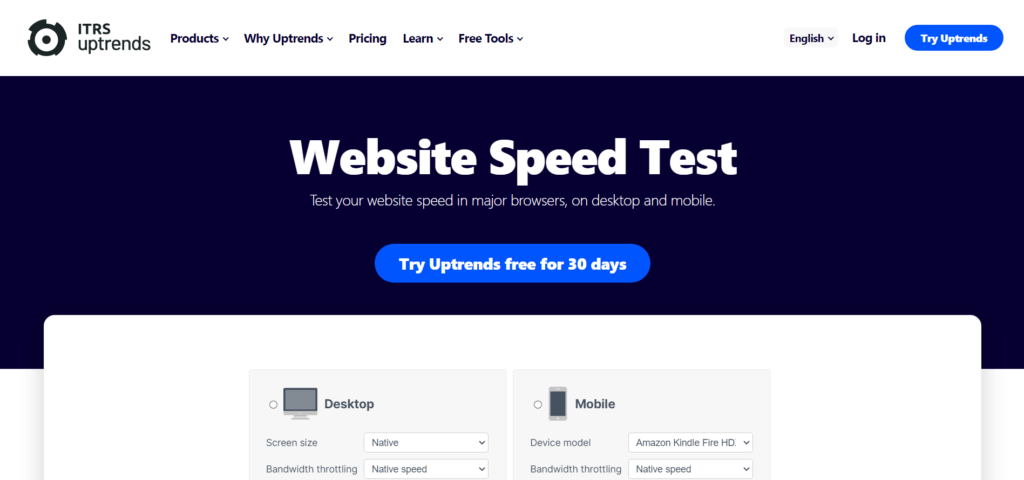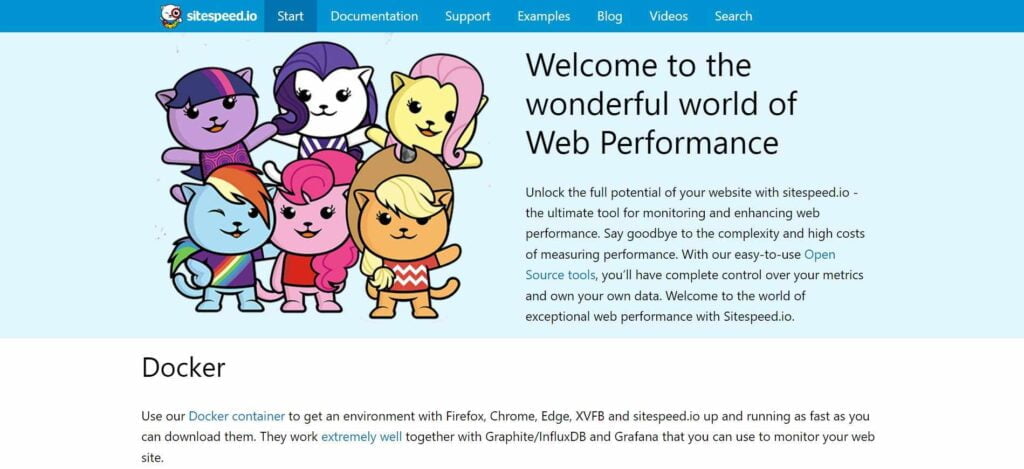Welcome to the fast lane of digital success! In the ever-accelerating online landscape, where every second counts, ensuring your website's speed is not just a necessity but a competitive advantage. In this digital age, user attention spans are fleeting, and search engines prioritize swift-loading sites.
Elevate your website's performance with the best website speed testing tools. Optimize website loading times, enhance user experience, and boost search rankings with these powerful tools. Discover the secrets to a lightning-fast website.
To help you navigate this need for speed, we've curated the ultimate guide to the Top 7 Best Website Speed Testing Tools you should be using.” Whether you're a seasoned webmaster or just dipping your toes into the realms of online optimization, these tools are your trusted companions on the journey to a faster, more efficient website.
The Importance of Website Speed
In the digital age, website speed holds immense significance, impacting user experience, search engine rankings, and overall online success. From an SEO standpoint, a fast-loading website is a key factor in attracting and retaining visitors, making it crucial for businesses and website owners to prioritize speed optimization.
Search engines, particularly Google, consider website speed as a ranking factor. Websites that load quickly are favored in search engine algorithms, leading to higher visibility in search results. This emphasis on speed underscores the importance of aligning with search engine guidelines for optimal SEO performance.
Beyond SEO, website speed directly influences user experience. In a world where attention spans are short, users expect websites to load swiftly and seamlessly. A slow website can result in high bounce rates, negatively impacting user satisfaction and potentially leading visitors to seek alternatives. Prioritizing speed optimization is, therefore, essential for keeping users engaged and fostering positive interactions.
Moreover, the strategic use of keywords related to website speed, woven naturally into the content, reinforces the SEO-friendly nature of the discussion. By incorporating relevant terms such as “website speed” and “speed optimization,” the content becomes more discoverable by search engines, further enhancing its potential to reach a broader audience.
In the realm of e-commerce, the importance of website speed becomes even more critical. Slow-loading pages can significantly hinder the conversion process, leading to potential revenue loss. A fast and responsive website, on the other hand, contributes to a seamless user journey, positively impacting conversion rates and overall business success.
To dive deeper into understanding website speed, one must explore the section of website speed testing tools. These tools are designed to assess and analyze a website's performance, providing valuable insights for optimization. The focus on finding the Best Website Speed Testing Tools reflects the ongoing pursuit of excellence in website speed optimization. These tools not only quantify the speed of a website but also offer actionable recommendations for improvement. With the right tools in hand, website owners and developers can embark on a journey to ensure that their sites not only meet but exceed user expectations in the fast-paced digital landscape.
Top 7 Best Website Speed Testing Tools
Fasten your seatbelts as we explore the tools that will not only measure but elevate your site's performance in 2024 and beyond. Let's dive into the realm of acceleration, where every millisecond matters!
1. Google PageSpeed Insights.

Google PageSpeed Insights stands out as a leading player among the best website speed testing tools, developed by the tech giant itself. This tool aims to evaluate the performance of your website on both desktop and mobile platforms, providing valuable insights into its loading speed and user experience. Google's emphasis on page speed as a crucial ranking factor makes PageSpeed Insights an invaluable resource for webmasters and SEO professionals.
How to Use It:
Using Google PageSpeed Insights is a straightforward process. Simply enter your website's URL into the provided field, and the tool quickly analyzes your site's performance. The results are presented in a user-friendly format, with color-coded scores indicating the level of optimization. The tool categorizes suggestions into high, medium, and low priority, making it easy for users to prioritize improvements based on their impact on overall speed.
Key Features:
Google PageSpeed Insights offers a range of key features for comprehensive performance analysis. It provides specific recommendations to address identified issues, including optimizing images, leveraging browser caching, and minimizing server response times. Additionally, it distinguishes between lab data (simulated performance) and field data (real user experiences), offering a holistic view of your website's speed profile.
Pros & Cons:
Pros:
- Actionable Recommendations: PageSpeed Insights provides clear and actionable suggestions to improve website speed, aiding users in implementing effective optimizations.
- Mobile-Friendly Analysis: With a focus on mobile performance, the tool aligns with the increasing prevalence of mobile browsing, ensuring your site caters to a diverse user base.
- Integration with Lighthouse: The tool is integrated with Lighthouse, an open-source, automated tool for improving web page quality, allowing for more in-depth performance evaluations.
Cons:
- Limited Historical Data: PageSpeed Insights does not provide historical performance data, limiting the ability to track long-term trends in your website's speed.
- Reliance on Lab Data: The tool primarily relies on lab data, which may not fully represent real-world user experiences, leading to potential variations between lab and field data.
2. GTmetrix.

GTmetrix is undeniably one of the best website speed testing tools, renowned for its comprehensive approach to performance analysis. This tool offers an in-depth evaluation of your website's speed, combining insights from Google's PageSpeed and Yahoo's YSlow to provide a holistic performance score. Its user-friendly interface and detailed reports make it a go-to choice for webmasters and developers aiming to optimize their sites for maximum speed and efficiency.
How to Use It:
Using GTmetrix is a seamless process for users of all expertise levels. Simply input your website's URL into the provided field, and GTmetrix swiftly generates a detailed performance report. The report includes essential metrics such as page load time, total page size, and the number of requests, providing a clear snapshot of your site's current performance. The tool also allows users to choose testing locations, ensuring a comprehensive analysis from various geographic perspectives.
Key Features:
GTmetrix offers a robust set of key features that contribute to its status as one of the best website speed testing tools. The tool provides actionable recommendations, highlighting specific elements that impact your website's speed. With features like Waterfall Charts and Video Playback, users can visually assess how different components contribute to the overall loading time. Additionally, GTmetrix enables users to set performance budgets, ensuring ongoing optimization efforts align with specific goals.
Pros & Cons:
Pros:
- Comprehensive Analysis: GTmetrix combines data from multiple sources, providing a comprehensive analysis of your website's speed and performance.
- Actionable Recommendations: The tool offers detailed recommendations, helping users address specific issues affecting their site's speed effectively.
- Performance Monitoring: GTmetrix allows users to set up regular monitoring schedules, facilitating ongoing performance tracking and ensuring sustained optimization.
Cons:
- Limited Daily Tests: Free users of GTmetrix are limited to a certain number of daily tests, potentially restricting frequent and extensive performance assessments.
- Advanced Features in Pro Version: Some advanced features, such as historical data tracking and more frequent testing intervals, are available only in the Pro version, requiring a subscription for access.
3. Pingdom.

Pingdom is a standout among the best website speed testing tools, renowned for its combination of real user monitoring and synthetic testing. Developed by SolarWinds, Pingdom offers a comprehensive approach to assessing website performance. It allows users to gain insights into how real users experience their websites while also providing detailed reports based on synthetic tests. With its user-friendly interface and powerful features, Pingdom has become a go-to choice for businesses and website owners seeking to optimize their online presence.
How to Use It:
Using Pingdom is a straightforward process, making it accessible for users with varying levels of technical expertise. To initiate a test, users input their website's URL, and Pingdom quickly generates a performance report. One distinctive feature is the ability to choose from multiple testing locations worldwide, offering a global perspective on your website's speed. The tool then presents a waterfall chart, highlighting the loading times of different elements, helping users identify specific areas for improvement.
Key Features:
Pingdom's key features contribute to its reputation as one of the best website speed testing tools. Real user monitoring allows users to understand how actual visitors experience their websites, providing insights into geographical performance variations and user behavior. Synthetic testing, on the other hand, enables users to simulate visits from different locations, browsers, and devices. Pingdom's detailed reports include response time, uptime, and performance grades, offering a comprehensive overview of your website's speed and reliability.
Pros & Cons:
Pros:
- Real User Monitoring: Pingdom excels in real user monitoring, providing insights into actual user experiences and helping users tailor their optimizations to enhance the overall visitor experience.
- Detailed Reports: The tool generates detailed reports, including response time, uptime, and performance grades, aiding users in identifying specific areas for improvement.
- Alerts and Notifications: Pingdom offers alerting features, notifying users of downtime or performance issues, ensuring prompt responses to potential disruptions.
Cons:
- Pricing Structure: Some users may find Pingdom's pricing structure, based on the number of checks and test frequency, to be less flexible compared to other tools.
- Interface Complexity: While user-friendly, the interface may appear complex to beginners, potentially requiring some time for users to become familiar with all available features.
4. WebPageTest.

WebPageTest, an open-source tool, has earned its reputation as one of the best website speed testing tools available. Known for its flexibility and customization options, WebPageTest offers users a robust platform to evaluate and optimize their website's performance. Developed and maintained by Google, this tool allows users to conduct tests from multiple locations, browsers, and connection speeds, providing a comprehensive analysis of their site's speed and responsiveness.
How to Use It:
Using WebPageTest involves a user-friendly process that caters to both beginners and advanced users. To perform a test, users input their website's URL and select the desired testing parameters, including location, browser, and connection speed. WebPageTest then generates detailed results, including a waterfall chart that visually represents the loading times of individual elements. Users can also choose to run multiple tests, allowing for comparative analysis and identifying trends over time.
Key Features:
WebPageTest offers a variety of key features that contribute to its standing as one of the best website speed testing tools. Customizable testing options allow users to tailor their tests to specific scenarios, such as different browsers, devices, and network conditions. The tool provides detailed insights into various metrics, including Time to First Byte (TTFB), load times for different content types, and suggestions for optimization. WebPageTest's visualizations, such as filmstrip view and connection view, offer a granular understanding of the loading process.
Pros & Cons:
Pros:
- Customizable Testing: WebPageTest stands out for its flexibility, allowing users to customize tests based on their specific needs, including location, browser, and connection speed.
- Comprehensive Metrics: The tool provides a wide array of metrics, including detailed breakdowns of content loading times and suggestions for optimization, offering users a comprehensive view of their website's performance.
- Global Testing Locations: WebPageTest allows users to conduct tests from various locations globally, enabling a more accurate representation of how users worldwide experience their website.
Cons:
- Learning Curve: The wealth of features in WebPageTest may pose a learning curve for beginners, requiring some time to explore and understand the full extent of its capabilities.
- Limited Automation: While powerful, WebPageTest may not be as automated as some other tools, requiring users to initiate tests manually.
5. Uptrends.

Uptrends stands out as one of the best website speed testing tools, offering a comprehensive approach to monitoring and optimizing website performance. This tool specializes in multi-step transaction monitoring and real user monitoring, providing users with a deep understanding of their website's speed and reliability. Uptrends caters to a diverse user base, including webmasters, developers, and businesses, with its user-friendly interface and powerful features for continuous performance evaluation.
How to Use It:
Using Uptrends is a straightforward process designed to cater to users with varying levels of technical expertise. To initiate a test, users input their website's URL, and Uptrends performs multi-step transaction monitoring, simulating real user interactions. The tool also incorporates real user monitoring, collecting data from actual visitors to provide insights into their experiences. With a global network of monitoring locations, users can assess their website's speed from various geographic perspectives.
Key Features:
Uptrends boasts key features that contribute to its status as one of the best website speed testing tools. Multi-step transaction monitoring allows users to simulate complex user interactions, such as form submissions or shopping cart processes, providing a comprehensive performance evaluation. Real user monitoring captures data from actual visitors, offering insights into geographical variations in website speed and user behavior. Uptrends also provides detailed performance reports, including response times, uptime, and transaction success rates, empowering users to make informed optimization decisions.
Pros & Cons:
Pros:
- Multi-Step Transaction Monitoring: Uptrends excels in simulating complex user interactions, allowing users to evaluate the performance of critical website processes.
- Real User Monitoring: The tool incorporates real user monitoring, offering insights into how actual visitors experience the website and helping users tailor optimizations to enhance user satisfaction.
- Global Monitoring Network: With a global network of monitoring locations, Uptrends provides users with a diverse perspective on their website's speed, considering variations in performance across different regions.
Cons:
- Pricing Structure: Some users may find Uptrends' pricing structure, based on the number of monitors and monitoring locations, to be less flexible compared to other tools.
- Learning Curve: While user-friendly, the tool may pose a slight learning curve for beginners, particularly in navigating the advanced features related to multi-step transaction monitoring.
6. KeyCDN Website Speed Test.

Ensuring optimal website speed is essential for delivering a seamless user experience and positively impacting search engine rankings. KeyCDN offers a comprehensive Website Speed Test tool designed to analyze the performance of your website and provide valuable insights for optimization.
KeyCDN's Website Speed Test is a user-friendly tool that allows website owners and developers to assess their website's speed from various global locations. The tool provides crucial performance metrics, giving a detailed breakdown of page load times, file sizes, and the number of requests made during the loading process. This information is instrumental in identifying potential bottlenecks and optimizing the website for faster performance.
How to Use It:
Using KeyCDN's Website Speed Test is a straightforward process. Users simply input their website's URL into the provided field and choose a testing location from KeyCDN's global network. The tool then analyzes the website's performance, generating a detailed report that includes valuable metrics such as time to first byte (TTFB), fully loaded time, and waterfall charts illustrating the loading sequence of each website element. This user-friendly interface ensures that users of all levels of technical expertise can benefit from the insights provided.
Key Features:
KeyCDN's Website Speed Test comes equipped with key features that make it a valuable tool for website optimization. The tool offers performance scores based on various criteria, allowing users to quickly assess their website's overall speed. Additionally, it provides recommendations for improvement, suggesting specific actions to enhance performance, such as optimizing images or leveraging browser caching. With the ability to test from multiple locations, users can gain insights into how their website performs globally.
Pros & Cons:
Pros:
- Global Testing: KeyCDN's global network enables users to assess their website's speed from various locations worldwide, providing a comprehensive view of performance.
- Detailed Metrics: The tool offers detailed metrics, including waterfall charts and recommendations, empowering users to make informed decisions for optimization.
- User-Friendly Interface: KeyCDN's Website Speed Test provides a simple and intuitive interface, making it accessible for users with varying levels of technical expertise.
Cons:
- Dependency on CDN: As the tool is associated with a Content Delivery Network (CDN), its performance may be influenced by CDN-related factors, which could be a limitation for users not utilizing KeyCDN.
7. SiteSpeed.io

SiteSpeed.io is an open-source website speed testing tool designed to provide developers and website owners with a comprehensive analysis of their site's performance. Developed by the open-source community, this tool focuses on continuous performance testing and integration into the development workflow. SiteSpeed.io stands out as one of the best website speed testing tools due to its emphasis on delivering actionable insights for ongoing performance optimization.
How to Use It:
Using SiteSpeed.io involves a straightforward process, making it accessible for users with various technical backgrounds. Users can install SiteSpeed.io on their local machines or servers and run tests on specified websites. The tool supports testing multiple URLs simultaneously, allowing for efficient performance evaluations. It also integrates with Continuous Integration (CI) systems, enabling developers to incorporate performance testing into their development pipeline seamlessly. With support for various browsers, SiteSpeed.io ensures a thorough assessment of website speed across different platforms.
Key Features:
SiteSpeed.io offers key features that contribute to its recognition as one of the best website speed testing tools. Continuous performance testing allows users to monitor and analyze their website's speed consistently, identifying trends and potential issues over time. The tool provides comprehensive performance metrics, including page load times, asset sizes, and suggestions for optimizations. SiteSpeed.io also integrates with other performance testing tools and services, enhancing its versatility and usability in different development environments.
Pros & Cons:
Pros:
- Continuous Testing: SiteSpeed.io excels in continuous performance testing, allowing users to monitor their website's speed consistently and identify trends or issues over time.
- Integration Capabilities: The tool seamlessly integrates with Continuous Integration systems, making it a valuable asset for developers looking to incorporate performance testing into their development workflow.
- Comprehensive Metrics: SiteSpeed.io provides a wide range of performance metrics, including waterfall charts and asset breakdowns, offering detailed insights for optimization.
Cons:
- Learning Curve: For users new to performance testing, SiteSpeed.io may pose a learning curve in terms of understanding the various metrics and optimizing based on the provided recommendations.
- Server Installation: Installing SiteSpeed.io on a local machine or server is required, which might be a drawback for users who prefer web-based testing tools.
Importance of Regular Speed Testing
Regular speed testing with the best website testing tools is a crucial practice for website owners aiming to maintain optimal performance and user satisfaction. The focus keyword, best website testing tools, strategically placed throughout this discussion, underscores the importance of using top-tier tools for effective speed evaluations.
Frequent speed tests enable proactive issue detection, allowing website administrators to identify and address potential performance bottlenecks promptly. By employing the best website testing tools, users can pinpoint specific elements that might be affecting loading times, ensuring a swift and seamless experience for visitors.
In addition to enhancing user satisfaction, regular speed testing contributes to resource and time savings. By leveraging the insights gained from the best website testing tools, website owners can efficiently allocate resources, preventing potential disruptions and streamlining their site's functionality.
From an SEO perspective, the focus keyword emphasizes the significance of consistent speed optimization. Search engines prioritize fast-loading websites, and by routinely employing the best website testing tools, websites can maintain high search engine rankings, driving organic traffic and maximizing online visibility.
Furthermore, regular speed testing is not just about identifying existing issues; it's a proactive strategy for continuous improvement. The strategic placement of the focus keyword throughout highlights the importance of utilizing the best website testing tools consistently to implement optimizations based on test results, ensuring ongoing performance evolution.
As technology and user expectations evolve, the focus keyword serves as a reminder that regular speed testing is a means of future-proofing websites. By routinely assessing and optimizing with the best website testing tools, site owners can stay ahead of industry standards, providing a competitive edge and a seamless online experience for users.
Frequently Asked Questions (FAQs) about Best Website Speed Testing Tools
1. Why is website speed testing important?
Website speed testing is crucial for assessing the performance of your site. It helps identify areas for improvement, enhances user experience, and positively influences search engine rankings.
2. How do website speed testing tools work?
These tools analyze various metrics such as page load time, page size, and requests made to the server. They provide insights into how quickly your website loads and offer recommendations for optimization.
3. What are the key indicators of a fast website?
Fast websites typically have low page load times, optimized images, minimal server requests, and adhere to Core Web Vitals metrics, including Largest Contentful Paint (LCP), First Input Delay (FID), and Cumulative Layout Shift (CLS).
4. Which are the best website speed testing tools available?
Some top tools include Google PageSpeed Insights, GTmetrix, Pingdom, WebPageTest, and Lighthouse. Each has unique features, and the choice depends on specific needs and preferences.
5. How often should I test my website's speed?
Regular testing is recommended, especially after significant updates or changes to your website. Continuous monitoring ensures optimal performance and helps address any emerging speed issues promptly.
6. Can website speed impact my search engine rankings?
Yes, search engines, particularly Google, consider website speed as a ranking factor. Faster-loading sites are more likely to rank higher in search engine results pages (SERPs).
7. Are there common issues affecting website speed?
Yes, common issues include large image sizes, excessive server requests, unoptimized code, and slow hosting. Speed testing tools can help identify and address these issues.
8. What are Core Web Vitals, and why are they important?
Core Web Vitals are a set of user-focused metrics, including LCP, FID, and CLS, introduced by Google. They measure aspects of web page performance related to user experience, influencing SEO rankings.
9. How can I optimize my website based on speed test results?
Optimization strategies may include compressing images, minimizing HTTP requests, using a content delivery network (CDN), and implementing browser caching. Recommendations vary based on specific test results.
10. Do website speed testing tools work for mobile optimization?
Yes, many tools provide insights into mobile performance. Mobile optimization is crucial, considering the increasing number of users accessing websites on smartphones. Test results often include recommendations for improving mobile speed.

